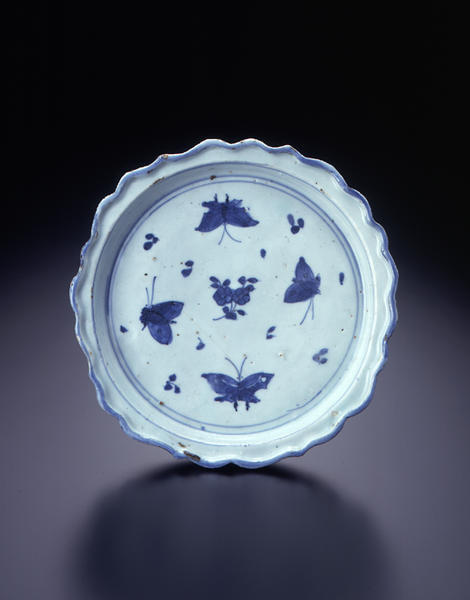古染付花蝶文平鉢
- 中国・景徳鎮窯
- 中国・明時代末ー清時代初
- 17世紀
- 染付磁製
- H-3.3 D-23
解説(春の玉手箱)
中国・景徳鎮の民窯で明時代末期から清時代初期にかけて作られた青花磁器を、日本では古染付と呼ぶ。もともと庶民の日用雑器として作られたものであるため、中国や欧米に遺品はほとんどない。むしろ日本からの注文で作られた輸出品も多かったことから、日本に伝世しているものがほとんどである。古染付の魅力は柔らかな釉調とその意匠のおもしろさにあるといえよう。特に向付には動物、鳥、蝶、魚貝、植物などさまざまなものが造形化されたものがあり、好みを焼かせた当時の茶人のデザイン感覚には感服させられる。古染付には胎土との収縮率の違いで釉がはじけた、いわゆる虫喰いといわれる部分が見られるのが特徴である。もちろん少ないほど上手で、また染付の発色も青の冴えたものほど喜ばれる。
柔かい釉調を呈するこの平鉢は本来何客かの組ものであったと思われるが、一枚のみが残っている。中央に花が、そのまわりに四羽の蝶が舞うように描かれた意匠は、清楚で優しく、いかにも春らしい上品な作となっている。口縁部は針木状に成形され、底部は露胎で蛇目高台様に削られている。
Catalogue Entry
The ceramics known in Japan as "ko‐sometsuke" are actually Chinese porcelains with underglaze blue decoration created at the non‐imperial kilns at Jingdezhen during China's late Ming and early Qing dynasties. Originally these wares were used as everyday dishes by the common classes, and hence there are almost no extant examples of these wares found in China or the west today. It is also clear that a large percentage of the production of these kilns was made on order for export to Japan, and thus the majority of extant examples were handed down in Japanese collections. The beauty of ko‐sometsuke lies in its soft glaze and the interesting patterns created in underglaze blue decoration. These designs include images of animals, birds, butterflies, fish and shellfish, plants and other stylized forms, and often we can discern the tastes and preferences of the tea ceremony master who ordered the specific work to be created. Ko‐sometsuke works often have a creeping glaze tendency due to the difference in shrinkage rates of the body clay and glaze. Of course, the fewer of these creeping glaze edges, the more accomplished the work. Similarly the higher grade of these wares is distinguished by a particularly vivid bloom of the underglaze blue.
It is thought that this bowl would have been originally one of a set, but today this one bowl is all that remains. The central flower is surrounded by four flying butterflies, and their quiet elegance makes this a particularly lovely, spring‐like bowl. The edge is sharp, pointed edges, while the bottom has been left unglazed with a open‐holed foot style.
